





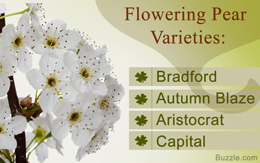 The Flowering Pear or Callery pear are generally non-fruit bearing trees. They are ornamental trees with dainty white flowers often adorning the streets, commercial landscapes, and residential lawns. The pear comes from the genus Pyrus, and belongs to the same family as the apple, Maloideae. The flowering pear tree's scientific name is Pyrus calleryana.
The Flowering Pear or Callery pear are generally non-fruit bearing trees. They are ornamental trees with dainty white flowers often adorning the streets, commercial landscapes, and residential lawns. The pear comes from the genus Pyrus, and belongs to the same family as the apple, Maloideae. The flowering pear tree's scientific name is Pyrus calleryana.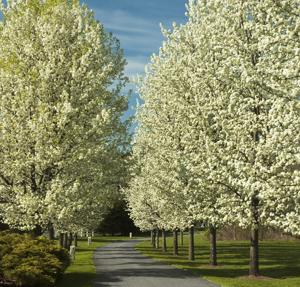 The Bradford or the Callery Pear is the most popular and fast-growing medium-sized tree. It is also the oldest pear tree type, and grows well in full sun and well-drained soil. It can grow up to 30 - 40 feet, and has an average lifespan of 15 years. This tree displays a wide array of delicate white flowers in early spring, and then in late fall their dark green foliage turns yellow. The only reason the Bradford is losing its popularity is because it is structurally weak and subject to breakage, specially during snowfall and heavy winds. It is however, pest and pollution resistant. Chanticleer Pear
The Bradford or the Callery Pear is the most popular and fast-growing medium-sized tree. It is also the oldest pear tree type, and grows well in full sun and well-drained soil. It can grow up to 30 - 40 feet, and has an average lifespan of 15 years. This tree displays a wide array of delicate white flowers in early spring, and then in late fall their dark green foliage turns yellow. The only reason the Bradford is losing its popularity is because it is structurally weak and subject to breakage, specially during snowfall and heavy winds. It is however, pest and pollution resistant. Chanticleer Pear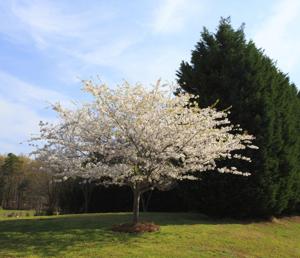 The Chanticleer or the Cleveland Select is considered an improved version of the Bradford Pear tree. In 2005, it was awarded the 'Urban Tree of the Year' by the Society of Municipal Arborists. These trees are sturdy and grow upright up to 40 feet high, with a spread that is 15 feet wide. The Chanticleer is popular as a street tree because it does not create a mess with its shedding. It bears big beautiful creamy white flowers in clusters during spring, and changes its green leaves to a purplish-red color in early fall. It also bears pea-sized fruit, which are inedible. Autumn Blaze Pear
The Chanticleer or the Cleveland Select is considered an improved version of the Bradford Pear tree. In 2005, it was awarded the 'Urban Tree of the Year' by the Society of Municipal Arborists. These trees are sturdy and grow upright up to 40 feet high, with a spread that is 15 feet wide. The Chanticleer is popular as a street tree because it does not create a mess with its shedding. It bears big beautiful creamy white flowers in clusters during spring, and changes its green leaves to a purplish-red color in early fall. It also bears pea-sized fruit, which are inedible. Autumn Blaze Pear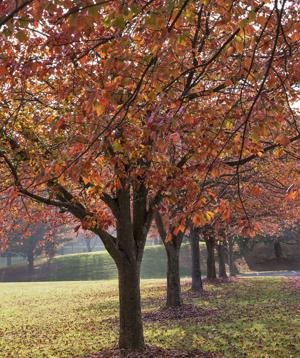 The Autumn Blaze is known for its brilliant red leaves and huge round structure. It can grow up to 45 feet with a spread of 30 feet. It only grows in full sunlight, and unlike other pear trees, it is less susceptible to breakage and winter damage. In fall, the color of this tree changes in hues of yellow, orange or blaze, lasting as long as three weeks, and then turns deep burgundy. Because of this, these trees are planted more for the fall foliage than white flowers. Under ideal conditions, the autumn blaze has an expected lifespan of 30 years. Aristocrat Pear
The Autumn Blaze is known for its brilliant red leaves and huge round structure. It can grow up to 45 feet with a spread of 30 feet. It only grows in full sunlight, and unlike other pear trees, it is less susceptible to breakage and winter damage. In fall, the color of this tree changes in hues of yellow, orange or blaze, lasting as long as three weeks, and then turns deep burgundy. Because of this, these trees are planted more for the fall foliage than white flowers. Under ideal conditions, the autumn blaze has an expected lifespan of 30 years. Aristocrat Pear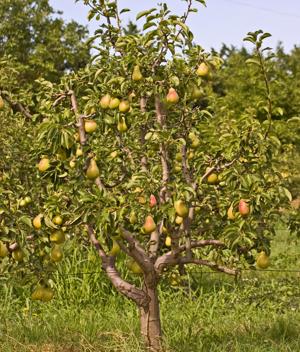 This tree is attractive all year round. In early spring, it dons its beautiful (but often foul-smelling) flowers, dark green and shiny deep-purplish leaves from mid to late fall. This tree is very sturdy and can withhold harsh winters. It looks huge because of its wide-spun pyramidal shape, and can reach a height of 35 to 45 feet. These are quite preferable for beautifying the outdoors and streets. Trinity Pear
This tree is attractive all year round. In early spring, it dons its beautiful (but often foul-smelling) flowers, dark green and shiny deep-purplish leaves from mid to late fall. This tree is very sturdy and can withhold harsh winters. It looks huge because of its wide-spun pyramidal shape, and can reach a height of 35 to 45 feet. These are quite preferable for beautifying the outdoors and streets. Trinity Pear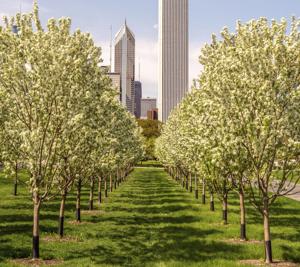 The Trinity Pear is one of the best ornamental trees around. It is a new hybrid that only attains a height of about 20 feet. Its small size and tightly-rounded form makes it easier for gardeners who have a small space to work in to enjoy its beauty without worrying about the space constraints. It blooms smaller flowers, and with the advent of fall, it changes its color to a striking reddish-orange. Jack Pear
The Trinity Pear is one of the best ornamental trees around. It is a new hybrid that only attains a height of about 20 feet. Its small size and tightly-rounded form makes it easier for gardeners who have a small space to work in to enjoy its beauty without worrying about the space constraints. It blooms smaller flowers, and with the advent of fall, it changes its color to a striking reddish-orange. Jack Pear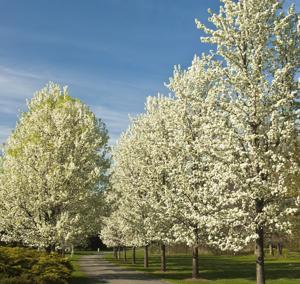 The Jack Pear or the Jaczam (as it is popularly known) grows to a height of just around 15 feet. It is one of the smallest varieties of the flowering pear trees, and also grows considerably slower than its counterparts. It has an upright oval shape, which is ideal for sidewalks and yards. These ornamental trees are an excellent choice as they display clusters of creamy white flowers in spring and brilliant purple leaves in winter. They add a refined outline in the summers with their rich dark green foliage. These trees are a landscaper's delight as they are disease-resistant as well. Redspire Pear
The Jack Pear or the Jaczam (as it is popularly known) grows to a height of just around 15 feet. It is one of the smallest varieties of the flowering pear trees, and also grows considerably slower than its counterparts. It has an upright oval shape, which is ideal for sidewalks and yards. These ornamental trees are an excellent choice as they display clusters of creamy white flowers in spring and brilliant purple leaves in winter. They add a refined outline in the summers with their rich dark green foliage. These trees are a landscaper's delight as they are disease-resistant as well. Redspire Pear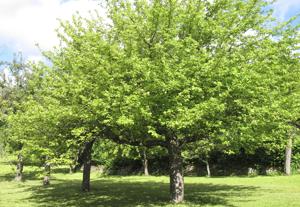 The Redspire Pear is widely known for its large white flowers and beautiful fall colors. This tree is mostly used for beautifying residential streets and curbs, as it has a symmetrical growth and is very easy to maintain. It is pyramidal in shape and can reach a height of around 35 feet. The leaves of this tree are glossy green in color, but then turn yellow, gold or dark-red in fall. Capital Pear
The Redspire Pear is widely known for its large white flowers and beautiful fall colors. This tree is mostly used for beautifying residential streets and curbs, as it has a symmetrical growth and is very easy to maintain. It is pyramidal in shape and can reach a height of around 35 feet. The leaves of this tree are glossy green in color, but then turn yellow, gold or dark-red in fall. Capital Pear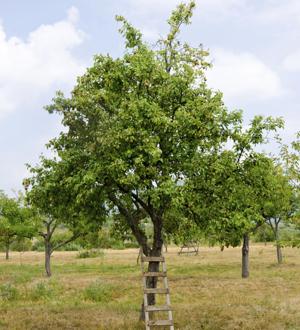 The Capital Pear Tree is a narrow columnar flowering pear tree, and is without thorns. It can grow to a height of around 25 to 35 feet, and has a spread of around 8 to 10 feet. This tree bears white 5-petaled flowers in early spring, and displays an array of beautiful green foliage all year long. In fall, the leaves change from reddish-purple to reddish-bronze, making it look very attractive. However, these trees are susceptible to limb-breakage during strong windy conditions and fireblight. They are still preferred by many for their smaller size and dramatic fall color. Choose any one of these pretty adornments for your garden or surrounding landscape, and enjoy the delightful snowy white flowers and brilliant color palettes all year around.
The Capital Pear Tree is a narrow columnar flowering pear tree, and is without thorns. It can grow to a height of around 25 to 35 feet, and has a spread of around 8 to 10 feet. This tree bears white 5-petaled flowers in early spring, and displays an array of beautiful green foliage all year long. In fall, the leaves change from reddish-purple to reddish-bronze, making it look very attractive. However, these trees are susceptible to limb-breakage during strong windy conditions and fireblight. They are still preferred by many for their smaller size and dramatic fall color. Choose any one of these pretty adornments for your garden or surrounding landscape, and enjoy the delightful snowy white flowers and brilliant color palettes all year around.
Copyright © www.100flowers.win Botanic Garden All Rights Reserved